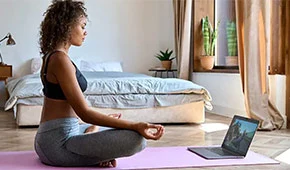
Yoga, Meditation and Pranayama for Insomnia and Sleep Disorders
By Laura Mendez
What is Sleep?
Sleep is defined in Wikipedia as a “naturally recurring state characterised by reduced or absent consciousness, relatively suspended sensory activity, and inactivity of nearly all voluntary muscles”.
Sleep plays a significant role in brain development. Sleep enables the brain to perform vital housekeeping tasks, such as organising long term memory, integrating new information and repairing and renewing tissue and nerve cells. Sleep allows the mind to sort out past, present and future activities and feelings. In other words, we have to sleep in order to maintain normal levels of cognitive skills such as speech, memory, innovative and flexible thinking.
A good way to understand the role of sleep is to look at what would happen if we didn’t sleep. Lack of sleep has serious effects on our brain’s ability to function. Studies have shown that without enough sleep, a persons ability to perform even simple tasks declines dramatically. Persistent sleep deprivation can cause significant mood swings, erratic behavior, hallucinations, and in the most extreme, yet rare cases, death. Research also shows that sleep-deprived individuals often have difficulty in responding to rapidly changing situations and making rational judgements.
How much Sleep Do We Need?
We’ve all been told that we should get eight hours of sleep per night. This information is an average, and might not be a perfect fit for everyone. Some may need more sleep, and others less, and our needs may change through the years.
Everyone has a sleep need that is likely determined by our genes. This need is the amount of sleep our body requires for us to wake up feeling refreshed. This likely occurs across a spectrum, with “short-sleepers” needing less than average and “long-sleepers” needing more. The average amount of sleep needed changes over our lifetime.
What is insomnia?
According to Timothy McCall M.D in his book “Yoga as a medicine”, the definition of insomnia is “the inability to fall asleep or to stay asleep long enough to feel rested”. It is the most common sleep complaint. Insomnia is often a symptom of another problem, such as stress, anxiety, depression, or an underlying health condition, like heartburn or chronic pain. People with insomnia have one or more of the following symptoms:
- difficulty falling asleep
- waking up often during the night and having trouble going back to sleep
- waking up too early in the morning
- having un-refreshing sleep
- having at least one daytime problem such as fatigue, sleepiness, mood swings, lack of concentration, etc.
Insomnia varies in how long it lasts and how often it occurs. Insomnia can be short-term (acute insomnia) or can last a long time (chronic insomnia). It can also come and go, with periods of time when a person has no sleep problems. Acute insomnia can last from one night to a few weeks. Insomnia is called chronic when a person has insomnia at least three nights a week for a month or longer.
What can cause sleep disorders?
Poor sleep can be the result of a variety of medical conditions ranging from depression to chronic pain. Hormonal changes and heartburn can cause insomnia. Working on rotating shifts or travelling across time zones also contribute to sleeplessness. Other factors that lead to poor sleep quality are major life changes, good and bad, such as the death of a loved one, getting a new job or losing your job.
What you ingest can also affect your sleep. Caffeine is a stimulant that can interfere with sleep and it is found not only in coffee, tea, soft drinks and chocolate, but also in some nonprescription pain relievers. Prescription medication, like blood pressure pills or anti-depressants like Prozac, can all contribute to insomnia. Nicotine and alcohol are other common culprits in sleep problems. Although alcohol may help you drop off, it acts as a stimulant after a few hours, contributing to early morning waking and unrefreshing sleep.
The most common cause for insomnia is stress, causing an hyperarousal of the nervous system and activating the sympathetic nervous system.
Meditation for Insomnia
– It stops an overactive brain – it slows down your constant irritating thought processes which makes it much easier to fall asleep
– The stress hormones in your body are significantly reduced, which makes it easier to rest/fall asleep. This should stop the “(too) early morning wakefulness” too
– As meditation is a relaxation exercise, it greatly stimulates your body and minds natural relaxation response, which makes all kinds of rest(/sleep) come that much easier.
Patanjali advises meditation to stop restlessness. In this state, the mind goes to the root of each problem and finishes with it, and then sleep gives complete rest to the organism. But not all meditative techniques will help you to sleep. Some will actually cause further stimulation and keep you awake.
An example of meditation that can help you to sleep is the mindful breathing meditation:
Lying in bed, keep your awareness focused on the sensations of the breath in your belly, observing the rise and fall of the abdominal muscles.
It’s important to keep your awareness focused on the belly rather than any other part of the breathing process, because this is the most calming place to observe your breathing. The sensations in the chest, throat, and head are actively stimulating, and so observing the breath in those places would be counter-productive.
Pay more attention to the exhale rather than the inhale. The easy way to do this is to count to the end of each exhale, and by consciously making the exhale slightly longer than the inhale. You can also mentally say the word “exhale” as you exhale. The exhale is more relaxing, while the in-breath is more stimulating.
Another meditation you can try before bedtime is focus on your third eye or ajna chakra. This is said to stimulate the pineal gland and, thus, the production of melatonin, a sleep inducing hormone.
Headspace also has a great series of guided meditations for sleep.
Pranayama for Insomnia
Pranayama is the science of breath control. In pranayama, the mind and consciousness is withdrawn deep inside to the core of the being. This stabilises and optimises all functions of the body. Only in this stillness can energy levels of the body be harmonised.
Normally, our thoughts and our breathing are directly related, when we are angry or restless, the number of breaths per minute increases rapidly. By controlling breathing one can control the emotions and reduce unnecessary thoughts.
Here are some great pranayama exercises to promote sleep:
sit in a comfortable position or lie on your back. Inhale and exhale through your nose making a deep, sibilant breath noise, a sound like the one made when you fog a mirror with your breath. Feel the air as it passes the back of your throat. Close your eyes and focus your attention on the sound of the breath in your throat. Allow this attention to take you away from any sounds around you. Continue the practice for a minute or two.
Nadi Sodhana or Alternate Nostril Breathing
sit in a comfortable position with a straight spine and keep your eyes closed. Exhale deeply and close your right nostril with the thumb of your right hand. Inhale through your left nostril counting until five. Close your left nostril with the ring finger of your right hand and exhale through the right nostril counting five. Inhale through your right nostril, close the right nostril with the thumb and exhale through your left nostril counting five. This is one cycle. Do as many cycles as it feels comfortable.
sit in a comfortable position. Plug your ears using your index or your middle finger, your forearms are parallel to the floor. After a full inhalation, begin making a gentle buzzing sound as you slowly exhale. The sound should come from the lower throat and should be soothing. Allow your attention to become fully absorbed in the sound of the vibration. When you run out of air, inhale slowly and deeply. Repeat the cycle.
Another breathing routine you can try is slow breathing with the emphasis on gradually lengthening the exhalation. This practice can be done lying in bed. Breathing through the nose, inhale for a count of four and exhale for a count of four. Do that twice, then inhale for four and exhale for six. After two times, increase the count of the exhalation to eight and so on, going up to ten and twelve as tolerated. Never stretch the exhalation any longer than is perfectly comfortable, or you will activate your sympathetic nervous system. Once you reach the maximum exhalation length at which you are comfortable, you can continue until you fall asleep.
Watch: Evening Meditation and Pranayama with Lalit
Here are some other simple steps you can take to improve your sleep:
- Acupuncture is useful in some cases of chronic insomnia.
- Valerian root, an herbal remedy, appears to be safe for short term use. Other safe herbal sleep aids include passion flower, lemon balm and hops.
- Studies have found that aromatherapy using diffused essential lavender oil helped elderly patients to sleep longer with fewer periods of restlessness.
- Avoid caffeine, alcohol, nicotine and chemicals that interfere with sleep for four to six hours before bedtime. Although alcohol may help bring on sleep, after a few hours it acts as a stimulant, decreasing the quality of sleep later in the night.
- A quiet, dark and cool environment can help promote sound sleep.
- Avoid stressful, stimulating activities, like working or discussing emotional issues. If you tend to take your problems to bed, try writing them down, and them putting them aside.
- If your clock is visible in the dark, turn it to face the wall. Watching the clock during wakeful periods may make you more anxious and less likely to sleep.
- If you wake up in the middle of the night and can’t get back to sleep in about 20 minutes, get up and engage in a quiet, restful activity such as reading or listening to music. Keep the lights dim as bright light can stimulate your internal clock. When your eyelids are dropping and you are ready to sleep, return to bed.
- Finish dinner several hours before bedtime and avoid foods that cause indigestion.
- Exercise can help you fall asleep and sleep more soundly, but try to finish exercising at least three hours before going to bed.
- To keep your internal clock set correctly, go to bed and wake up at the same time each day. Try to stick as closely as possible to your routine also on weekends.
Taken from Himalaya Yoga Valley Internship assignment ‘Yoga for the Treatment of Sleep Disorders’ By Laura Mendez – Himalaya Yoga Valley Graduate and Intern
You can find about Laura’s teaching by visiting her website





